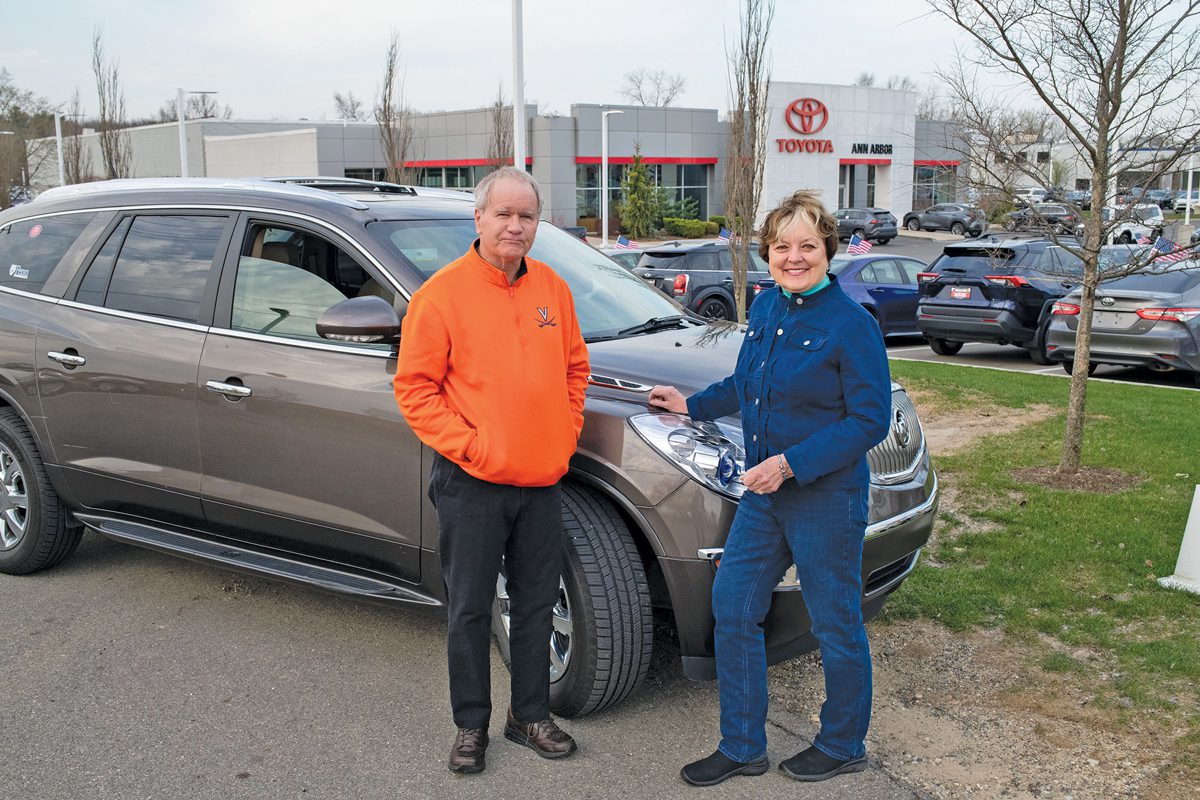
Writer Cynthia Furlong Reynolds and her husband Mark found inventory scarce when they looked into replacing their ten-year-old Buick before Trump’s tariffs kicked in. | Photo by Mark Bialek
For six months, our daughter Elizabeth had been considering a trade: the six-year-old Hyundai Tucson SUV she bought before moving to Maine for a hybrid with the latest safety features. “I wasn’t in a rush, but I thought it might be a good idea,” she told us. But as soon as automotive tariffs were announced, she leaped into action. Within two days, she created spreadsheets with pros and cons of different models, visited four Hyundai dealers, listed—and sold—her old Tucson, and drove out of the dealer’s parking lot with a shiny new hybrid.
My husband and I had been wondering about replacing our own second car, a ten-year-old Buick Enclave SUV with 146,000 miles. As soon as we learned about the tariffs, we, too, hurried to dealer showrooms to see what we could find.
We weren’t alone: U.S. vehicle sales in March were up more than 9 percent from a year earlier, according to automotive information platform MarkLines. As analysts predicted tariffs could raise prices between $3,000 and $10,000 industry-wide, our friends Alicia and John Rasley, who’d been looking at a new Ford, instead chose a BMW priced $10,000 higher than they had originally budgeted. “We have always bought used cars and kept them a long time,” Alicia told me, “but if the tariff remains in effect for years, we want a new car, one we can depend on and really enjoy.”
“I wish I could tell you what I think about the tariff situation—but if I did, I’d probably be put in jail,” jokes a personable young Lexus sales rep. He, like every car salesman and sales general manager, only spoke to the Observer with the understanding they would remain anonymous.
An hour before closing on a rainy Friday night in April, the sales manager at Toyota of Ann Arbor has thirty-seven potential customers waiting anxiously for attention. Within a half hour of opening the next day, every Toyota salesperson was working with a customer. More waited impatiently, with team members hurrying to find them seats and water bottles. Meanwhile, across the street, protesters outside the Tesla dealership were waving signs and getting sympathetic beeps from passing cars.
“I have to say, I’ve seen more customers driving into our lot with Teslas than ever before, hoping to make a change,” one salesman observed as he ushered us to his desk. A half hour later, he admitted, “I have absolutely no idea what the price of a new Toyota Highlander will be now—and the Highlander is built in Princeton, Indiana, not overseas. I don’t even know if I can get one.”
He pulled up a list of eight Highlanders on his computer: three were at least four years old; the other five weren’t built but were already sold. Nothing was available on the lot or showroom floor. “We’ve heard nothing from management about what to expect for inventory or what to charge for these or future cars.”
The day after Donald Trump’s “Liberation Day,” Ford announced that it would give every customer the company’s coveted employee discount, offering savings as high as 10 percent off the manufacturer’s suggested retail price. “And we planned ahead. We have plenty of cars,” a Varsity Ford salesman reported. “I would definitely say our business is brisk. We’re offering the best value for excellent products.”
He added, “fortunately, a lot of Ford’s parts are not made overseas. Our inventory is enormous right now, almost back to pre-Covid levels. Everyone used to wait for end-of-the-year deals. Not any longer.”
In February, the average new car price hovered around $48,000, up 25 percent from five years earlier, according to Kelly Blue Book. And that was before the 25 percent automotive import tariffs President Trump put into effect April 3.
Comments in the national media are gloomy. Wedbush Securities analyst Daniel Ives predicts the average new car price could actually increase “anywhere from $5,000 to $10,000 out of the gates,” while Art Wheaton, director of labor studies at Cornell, anticipates that some could see prices hike as much as $20,000 if automakers pass the full tariff cost on to customers.
A Detroit-based automotive advisory firm has suggested that U.S. and Canada auto sales could decline by 1.8 million vehicles this year and stagnate over the next decade if the global trade war escalates. It predicts that if the current tariffs stay in place for a decade, sales of light-duty vehicles in the U.S. and Canada will be nearly seven million units below the 24.6 million sales that would be expected in an integrated global economy.
After seeing a shortage of available inventory and watching stock markets tumble, we decided to keep our Enclave—despite warnings that repair costs will also rise steeply, since many parts are imported.
“It’s a gamble: do we pay more for the upkeep of an older car, or do we buy a new car now, hoping we won’t need expensive service visits until the tariff situation changes for the better?” my husband observed. I figured that between the uncertainty with Social Security and the international situation, we’d better save every cent we have right now.
And then, three days later, we met with our financial advisor. We were certain that he would commend us for our conservative financial decision—but we were surprised.
“Car prices are definitely going up,” he told us. “If you need to trade that Enclave in within a year or two, I’d advise doing it now—and the sooner, the better, before pre-tariff inventories are gone.”
Back to the dealers we go—fast.